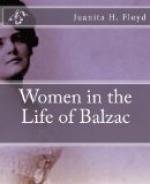Madame Hanska felt that she was growing old, but Balzac assured her that he should love her even were she ugly, and he relieved her mind of this fear by writing in her Journal intime that although he had not seen her since they were in Vienna, he thought her as beautiful and young as then—after an interval of seven years.[*]
[*] Balzac should have said an interval of eight
years instead of
seven, for he visited
her in Vienna in May and June, 1835, and
he wrote this in September
1843. This is only one of the
novelist’s numerous
mistakes in figuring, seen throughout his
entire works.
Balzac arrived in St. Petersburg on July 17_29, and left there late in September,[*] 1843, stopping to visit in Berlin and Dresden. Becoming very ill, he cut short his visit to Mayence and Cologne and arrived in Paris November 3, in order to consult his faithful Dr. Nacquart. Excess of work, the sorrow of leaving Madame Hanska, disappointment, and deferred hopes were too much for his nervous system. His letters to Madame Hanska were, if possible, filled with greater detail than ever concerning his debts, his household and family matters, his works and society gossip. The tu frequently replaces the vous, and having apparently exhausted all the endearing names in the French language, he resorted to the Hebrew, and finds that Lididda means so many beautiful things that he employs this word. He calls her Liline or Line; she becomes his Louloup, his “lighthouse,” his “happy star,” and the sicura richezza, senza brama.
[*] Unless the editor of Lettres a l’Etrangere
is confusing the
French and Russian dates,
he has made a mistake in dating certain
of Balzac’s letters
from St. Petersburg. He had two dated October
1843, St. Petersburg, and
on his way home from there Balzac writes
from Taurogen dating his letter
September 27-October 10, 1843.
Hence the exact date of his
departure from St. Petersburg is
obscure.
Madame Hanska and Balzac seem to have had many idiosyncrasies in common, among which was their penchant for jewelry, as well as perfumes. Since their meeting at Geneva, the two exchanged gifts of jewelry frequently, and the discussion, engraving, measuring, and exchanging of various rings occupied much of Balzac’s precious time.




